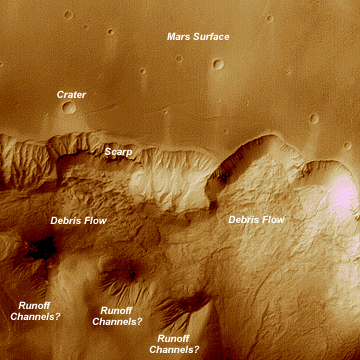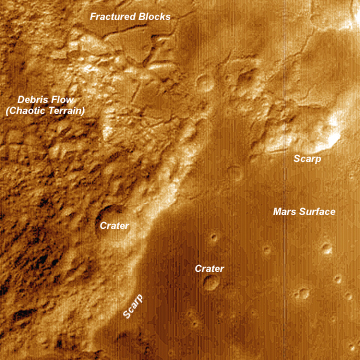Virtual Vista: Ophir Chasma and Aureum Chaos, MarsMass wasting processes are common across the surface of Earth, and it appears
similar processes have been common at some point during Mars' evolution. During
the Viking missions of the late 1970's, a number of remarkable images of apparent
mass wasting features on the Martian surface were obtained. Presently, the
Mars Orbital Camera onboard the Mars Global Surveyor is acquiring high-resolution
images of the Martian surface. On Earth, large landslides are often triggered when oversteepened slopes
become water-saturated and gravity causes the mass to slide. The occurrence
of features on Mars with similar morphologies has fueled speculation regarding
the potential role of liquid water during some interval of the planet's history.
 <a onClick="window.open('/olcweb/cgi/pluginpop.cgi?it=jpg::::/sites/dl/free/0077373731/30425/VirtualVista0901.jpg','popWin', 'width=NaN,height=NaN,resizable,scrollbars');" href="#"><img valign="absmiddle" height="16" width="16" border="0" src="/olcweb/styles/shared/linkicons/image.gif"> (181.0K)</a> <a onClick="window.open('/olcweb/cgi/pluginpop.cgi?it=jpg::::/sites/dl/free/0077373731/30425/VirtualVista0901.jpg','popWin', 'width=NaN,height=NaN,resizable,scrollbars');" href="#"><img valign="absmiddle" height="16" width="16" border="0" src="/olcweb/styles/shared/linkicons/image.gif"> (181.0K)</a>
Image from NASA/JPL/Malin Space Science Systems (MOC-E03-02064)
The image above shows spectacular landslides along a portion of the northern
wall of Ophir Chasma within the great equatorial canyon complex, Valles Marineris.
Evidence of the influence of a fluid (possibly water) on development of these
landslides is suggested by the apparent fluid nature of the slides and the
occurrence of gullies or channels reminiscent of outflow gullies and channels
observed emanating from large landslides on Earth.
Not all mass wasting processes on Mars have Earthly counterparts, however.
The image below shows a portion of Aureum Chaos, one of many so-called chaotic
terrains on Mars. Vast areas of the Martian surface are covered by chaotic
terrains that appear to be composed of large blocks of Martian crustal rocks
that disintegrated and were carried as debris avalanches and flows great distances
across the Martian landscape. <a onClick="window.open('/olcweb/cgi/pluginpop.cgi?it=jpg::::/sites/dl/free/0077373731/30425/VirtualVista0902.jpg','popWin', 'width=NaN,height=NaN,resizable,scrollbars');" href="#"><img valign="absmiddle" height="16" width="16" border="0" src="/olcweb/styles/shared/linkicons/image.gif"> (185.0K)</a> <a onClick="window.open('/olcweb/cgi/pluginpop.cgi?it=jpg::::/sites/dl/free/0077373731/30425/VirtualVista0902.jpg','popWin', 'width=NaN,height=NaN,resizable,scrollbars');" href="#"><img valign="absmiddle" height="16" width="16" border="0" src="/olcweb/styles/shared/linkicons/image.gif"> (185.0K)</a>
Image from NASA/JPL/Malin Space Science Systems (MOC-M19-00123).
The chaotic terrains are believed to have formed when large areas of frozen
subsurface fluids (perhaps water) thawed causing the overlying crustal material
to lose support and fail over a large area. Note the labeled impact crater
within the chaotic terrain - this crater clearly post-dates the catastrophic
failure of the Martian crust. Additional images of Mars surface taken with the Mars Orbital Camera can
be accessed at Malin Space Science Systems
on the World Wide Web.
Points to Ponder: 1. How are the features visible in this Virtual Vista similar to those that can be observed on Earth? 2. What factors may contribute to the occurrence of mass wasting on Mars? 3. Are these features formed by ongoing, active processes on Mars or are they ancient features of the Martian landscape? 4. What observations might be used to determine how old these features are?
| 
